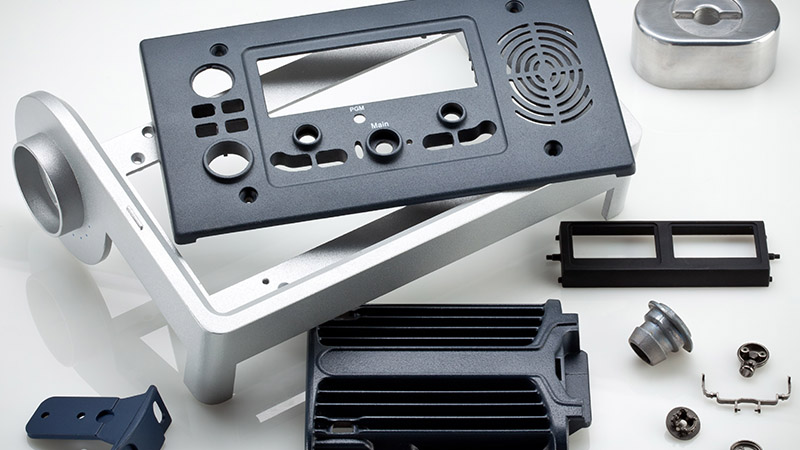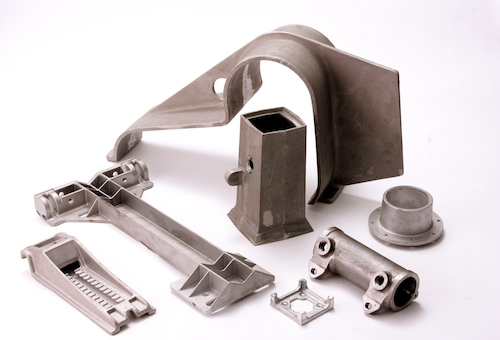Discovering the Important Applications and Use Aluminum Factory in Modern Production
Light weight aluminum shops play an important function in contemporary manufacturing, serving varied markets with their special residential properties. From auto components that boost gas effectiveness to aerospace structures that prioritize weight, aluminum's convenience is noticeable. Its applications encompass building and construction and customer electronic devices, highlighting its longevity and power efficiency. The developments in aluminum spreading strategies and future patterns call for a closer examination, as they may redefine its impact on production.
The Function of Aluminum Foundries in Automotive Production
As the vehicle industry significantly focuses on lightweight products to improve fuel performance and performance, aluminum foundries have actually become important factors to producing procedures. These factories focus on creating parts that satisfy the stringent needs of modern lorries, such as engine blocks, transmission housings, and structural aspects. Light weight aluminum's beneficial residential or commercial properties-- such as high strength-to-weight ratio, rust resistance, and superb thermal conductivity-- make it a suitable selection for automobile applications.
Aluminum shops utilize sophisticated spreading strategies, including die spreading and sand casting, to produce detailed and sturdy components. This ability allows producers to maximize designs for performance while lessening weight. The usage of light weight aluminum additionally supports sustainability goals, as it is extremely recyclable and minimizes power intake in cars. By promoting the combination of light weight aluminum right into auto design, foundries play an essential function fit the future of the auto industry, promoting efficiency and development across the board.
Aerospace Applications: Lightweight Solutions for Flight
Aluminum shops play a substantial duty in the aerospace field, where the need for light-weight products is extremely important for boosting gas efficiency and performance in airplane. The one-of-a-kind residential properties of light weight aluminum, including its high strength-to-weight proportion and rust resistance, make it an excellent choice for numerous aerospace parts. These parts consist of structural parts, engine casings, and touchdown equipment, which add to total aircraft performance.
The use of light weight aluminum alloys, specifically those established with sophisticated casting strategies, permits the production of elaborate designs and intricate shapes while decreasing weight. In addition, aluminum's recyclability aligns with the aerospace sector's sustainability goals, decreasing ecological effect. With constant improvements in aluminum shop modern technologies, makers can optimize manufacturing processes, leading to enhanced performance and lowered costs. As the aerospace field increasingly focuses on innovations that enhance efficiency, light weight aluminum foundries will certainly remain indispensable to establishing light-weight options for contemporary trip.
Structure and Building: Enhancing Structural Stability
In the structure and construction industry, a considerable focus is positioned on improving structural honesty through making use of aluminum. Recognized for its high strength-to-weight proportion, aluminum offers durability without compromising on weight, which is vital in contemporary building layouts. Its resistance to rust further guarantees long life, making it a perfect material for numerous structural parts, consisting of beam of lights, frameworks, and cladding.
Aluminum additionally promotes innovative layout possibilities, allowing engineers and engineers to develop aesthetically pleasing frameworks while preserving safety and security requirements. The product's flexibility allows its application in both household and industrial projects, from high-rises to bridges. Additionally, advancements in light weight aluminum factory methods have improved the accuracy of aluminum components, ensuring they meet strict building codes. Generally, the integration of aluminum in building and construction not only improves structural integrity however additionally contributes to lasting structure practices, provided its recyclability and energy-efficient production techniques.
Consumer Electronic Devices: The Increase of Aluminum in Innovation
In the domain name of customer electronics, aluminum has actually gained prestige because of its light-weight design advantages and premium thermal conductivity. This shift not only enhances product mobility but additionally improves gadget efficiency by efficiently dissipating warmth. As innovation remains to evolve, the duty of aluminum in creating smooth and effective gadgets is progressively significant.
Light-weight Style Benefits
As customer electronic devices advance, the demand for lightweight yet sturdy products has surged, making light weight aluminum a progressively popular choice among manufacturers. Its reduced thickness permits the development of smooth tools that are easy to carry and make use of, substantially boosting mobility. The strength-to-weight ratio of light weight aluminum guarantees that products can hold up against everyday wear and tear without compromising efficiency. Additionally, the pliability of aluminum enables suppliers to make detailed shapes and types, additionally adding to ingenious looks and functionality. This light-weight attribute also plays an important function in power effectiveness, as lighter tools call for much less energy to operate. As a result, light weight aluminum not just fulfills the progressing aesthetic demands yet additionally lines up with the contemporary concentrate on sustainability in customer electronics.
Thermal Conductivity Advantages
Thermal conductivity is an important consider the efficiency of consumer electronics, and light weight aluminum excels in this domain name. Its high thermal conductivity permits reliable warmth dissipation, which is vital for keeping ideal operating temperatures in tools such as mobile phones, laptop computers, and gaming consoles. By helping with quick warm transfer away from sensitive elements, light weight aluminum assists stop getting too hot, thereby boosting performance and prolonging tool long life. Additionally, the light-weight nature of aluminum complements its thermal residential properties, making it an excellent option for mobile technology. As manufacturers progressively prioritize performance and power efficiency, light weight aluminum's role in thermal management ends up being also a lot more considerable, causing its expanding adoption in modern digital layouts. This pattern underscores light weight aluminum's relevance in consumer electronic devices development.
Marine Industry: Deterioration Resistance in Harsh Settings
Corrosion resistance is a vital consider the aquatic industry, where tools and frameworks are regularly revealed to rough deep sea atmospheres. Aluminum, particularly in its alloy kinds, supplies significant benefits in this respect. Its natural oxide layer offers a protective barrier that avoids corrosion, making it excellent for vessels, anchors, and various other aquatic applications.
Marine-grade light weight aluminum alloys, such as 5083 and 6061, are especially created to endure the destructive impacts of saltwater and weather. These alloys not only withstand corrosion but also maintain structural integrity and strength in time. Applications range from hulls and superstructures of ships to components in overseas platforms.
The lightweight nature of aluminum further boosts its viability, making it possible for boosted gas performance and simplicity of handling - aluminum metal casting. As the aquatic market proceeds to concentrate on sturdiness and efficiency, aluminum remains a vital material selection for standing up to deterioration in demanding marine setups
Technologies in Light Weight Aluminum Spreading Techniques
While traditional light weight aluminum casting methods have served the market well, current developments are transforming the landscape of aluminum manufacturing. Methods such like it as 3D printing of cores and molds are getting grip, permitting fast prototyping and reduced preparations. This improvement makes it possible for suppliers to develop complicated geometries that were formerly tough to achieve with traditional spreading approaches. Additionally, improvements in die-casting technology, including using high-pressure die-casting (HPDC), have boosted the accuracy and surface coating of cast light weight aluminum elements, resulting in enhanced performance in various applications.
Furthermore, the adoption of investment spreading has permitted better style freedom and decreased material waste. aluminum metal casting. Innovations in alloy make-ups are additionally significant, as they improve mechanical residential or commercial properties and deterioration resistance. Generally, these developments not just enhance manufacturing procedures however likewise contribute to even more sustainable techniques within the aluminum foundry industry, making it adaptable to the evolving demands of modern manufacturing
Future Patterns in Aluminum Factory Manufacturing
The future of light weight aluminum foundry production is positioned for considerable makeover with automation, enhancing performance and precision in manufacturing processes. Lasting techniques are progressively ending up being a concern, as factories seek to decrease their ecological impact while fulfilling expanding regulative demands. In addition, developments in alloy development will certainly enable the creation of stronger, lighter products customized for diverse applications, driving development in the industry.
Automation in Shop Processes

Sustainable Production Practices
A growing focus on lasting production methods is reshaping the future of aluminum shop production. Market leaders are increasingly adopting energy-efficient technologies and reusing campaigns to lessen waste and decrease carbon impacts. Making use of recycled aluminum substantially decreases energy usage contrasted to main light weight aluminum production, making it a preferred selection for eco aware producers. Additionally, ingenious spreading methods are being created to enhance material performance and reduce discharges. Business are additionally buying sustainable energy resources, such as solar and wind, to power article source their operations sustainably. Aluminum Casting. By incorporating these techniques, the light weight aluminum shop market not only fulfills governing demands but additionally responds to customer demand for greener products, ultimately leading the way for a more lasting production landscape
Advanced Alloy Growth
Improvements in aluminum alloy growth are established to play a substantial function in the future of factory production, specifically as sustainability and efficiency demands escalate. The market is increasingly concentrating on developing high-strength, light-weight alloys that can endure extreme problems while lessening environmental impact. Scientists are discovering innovative structures, such as aluminum-lithium and aluminum-scandium alloys, which assure boosted mechanical buildings and lowered weight. Furthermore, the combination of advanced production strategies, including additive manufacturing and accuracy casting, enables more complicated geometries and reduced material waste. As governing stress and consumer preferences shift towards greener alternatives, the growth of recyclable and energy-efficient alloys will certainly be necessary. The future landscape of aluminum factory production rests on these developments in alloy modern technology.

Regularly Asked Inquiries
What Are the Environmental Impacts of Aluminum Foundry Operations?
Aluminum shop operations can result in significant ecological impacts, consisting of greenhouse gas emissions, energy consumption, and waste generation. Furthermore, inappropriate monitoring of toxins might cause dirt and water contamination, impacting regional communities and neighborhoods.
Exactly How Does Aluminum Recycling Affect Foundry Processes?
Light weight aluminum recycling improves shop processes by providing a cost-effective raw material, reducing energy consumption and exhausts. This lasting practice raises efficiency, minimizes waste, and supports the circular economic climate, benefiting both suppliers and the environment.
What Precaution Are Carried Out in Light Weight Aluminum Foundries?
Aluminum factories implement different security actions, consisting of personal safety devices, appropriate air flow systems, regular safety and security training, fire prevention methods, and tools upkeep treatments to decrease hazards and ensure a risk-free working environment for all staff members.
How Do Foundries Make Sure Quality Assurance in Aluminum Casting?
Shops assure high quality control in aluminum casting with extensive material assessments, exact temperature tracking, standardized procedures, and regular testing of actors products. These actions assist maintain uniformity, minimize issues, and satisfy market specifications successfully.
What Are the Expense Consider Light Weight Aluminum Factory Manufacturing?
Price variables in aluminum foundry production consist of resources rates, energy consumption, labor prices, devices upkeep, and overhead expenditures. In addition, manufacturing volume and intricacy of layouts greatly affect overall manufacturing costs and success.
As the auto sector increasingly prioritizes lightweight products to improve gas efficiency and performance, aluminum factories have become vital factors to producing procedures. Aluminum foundries play a considerable duty in the aerospace field, where the need for lightweight materials is extremely important for improving gas performance and performance in airplane. Additionally, improvements in light weight aluminum foundry techniques have actually enhanced the precision of light weight aluminum components, ensuring they satisfy rigid structure codes. While typical aluminum casting techniques have actually offered the industry well, current technologies are changing the landscape of light weight aluminum production. The usage of recycled light weight aluminum significantly decreases power usage contrasted to key aluminum production, making it a favored selection for eco mindful suppliers.